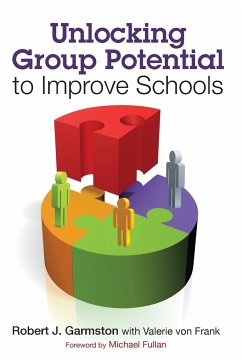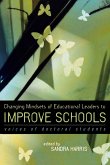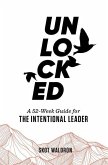- Broschiertes Buch
- Merkliste
- Auf die Merkliste
- Bewerten Bewerten
- Teilen
- Produkt teilen
- Produkterinnerung
- Produkterinnerung
How great groups make great schools This field book shows educators how to develop group culture, enhance facilitators’ skills, and optimize the group’s most precious resource—its members. The authors
Andere Kunden interessierten sich auch für
![Changing Mindsets of Educational Leaders to Improve Schools Changing Mindsets of Educational Leaders to Improve Schools]() Changing Mindsets of Educational Leaders to Improve Schools70,99 €
Changing Mindsets of Educational Leaders to Improve Schools70,99 €![Unlocked Unlocked]() Skot WaldronUnlocked20,99 €
Skot WaldronUnlocked20,99 €![Unleashing Your Leadership Potential Unleashing Your Leadership Potential]() Edith LucUnleashing Your Leadership Potential59,99 €
Edith LucUnleashing Your Leadership Potential59,99 €![Unlocking the Possibilities Unlocking the Possibilities]() Thomas M. EvansUnlocking the Possibilities41,99 €
Thomas M. EvansUnlocking the Possibilities41,99 €![Identifying Potential for Equitable Access to Tertiary Level Science Identifying Potential for Equitable Access to Tertiary Level Science]() Marissa RollnickIdentifying Potential for Equitable Access to Tertiary Level Science76,99 €
Marissa RollnickIdentifying Potential for Equitable Access to Tertiary Level Science76,99 €![Creating Change to Improve Science and Mathematics Education Creating Change to Improve Science and Mathematics Education]() Chong Ho YuCreating Change to Improve Science and Mathematics Education38,99 €
Chong Ho YuCreating Change to Improve Science and Mathematics Education38,99 €![Unlocking the Possibilities Unlocking the Possibilities]() Thomas M. EvansUnlocking the Possibilities88,99 €
Thomas M. EvansUnlocking the Possibilities88,99 €-
-
-
How great groups make great schools This field book shows educators how to develop group culture, enhance facilitators’ skills, and optimize the group’s most precious resource—its members. The authors
Produktdetails
- Produktdetails
- Verlag: Corwin
- Seitenzahl: 280
- Erscheinungstermin: 19. April 2012
- Englisch
- Abmessung: 229mm x 152mm x 15mm
- Gewicht: 410g
- ISBN-13: 9781412998895
- ISBN-10: 1412998891
- Artikelnr.: 34981667
- Herstellerkennzeichnung
- Libri GmbH
- Europaallee 1
- 36244 Bad Hersfeld
- gpsr@libri.de
- Verlag: Corwin
- Seitenzahl: 280
- Erscheinungstermin: 19. April 2012
- Englisch
- Abmessung: 229mm x 152mm x 15mm
- Gewicht: 410g
- ISBN-13: 9781412998895
- ISBN-10: 1412998891
- Artikelnr.: 34981667
- Herstellerkennzeichnung
- Libri GmbH
- Europaallee 1
- 36244 Bad Hersfeld
- gpsr@libri.de
Robert J. Garmston is Emeritus Professor of Educational Administration at California State University, Sacramento. He is co-developer of Cognitive Coaching with Art Costa and co-developer of Adaptive Schools with Bruce Wellman. He has worked as an educational consultant and made presentations and conducted workshops for teachers, administrators, and staff developers on leadership, learning, and personal and organizational development in twenty-four countries on five continents. Formerly an administrator and teacher in Saudi Arabia and the United States, his work has been translated into Arabic, Dutch, Hebrew, Italian, and Spanish. Bob lives in El Dorado Hills, California, near his five children and five (bright and cute) grandchildren.
Foreword
Preface
Acknowledgments
About the Authors
Introduction
I. Getting Work Done
1. Building Effective Groups
2. Understanding Group Roles
3. Examining Decision Making
4. Creating Focused Agendas
II. Developing Collaborative Communities
5. Forming Smarter Groups
6. Learning the Way Groups Talk
7. Challenging Mental Models
8. Working With Conflict
III. Developing a Sense of Community
9. Becoming a Self-Directed Group
10. Enhancing Energy Sources
IV. Developing Facilitation Skills
11. Developing Facilitation Skills
12. Learning the Language of Facilitation
13. Intervening Successfully
14. Setting up the Room
Conclusion
Appendix A: Large Group Room Configurations
Appendix B: Sample Inventory
Appendix C: Seven Norms of Collaboration: A Supporting Toolkit
Index
Preface
Acknowledgments
About the Authors
Introduction
I. Getting Work Done
1. Building Effective Groups
2. Understanding Group Roles
3. Examining Decision Making
4. Creating Focused Agendas
II. Developing Collaborative Communities
5. Forming Smarter Groups
6. Learning the Way Groups Talk
7. Challenging Mental Models
8. Working With Conflict
III. Developing a Sense of Community
9. Becoming a Self-Directed Group
10. Enhancing Energy Sources
IV. Developing Facilitation Skills
11. Developing Facilitation Skills
12. Learning the Language of Facilitation
13. Intervening Successfully
14. Setting up the Room
Conclusion
Appendix A: Large Group Room Configurations
Appendix B: Sample Inventory
Appendix C: Seven Norms of Collaboration: A Supporting Toolkit
Index
Foreword
Preface
Acknowledgments
About the Authors
Introduction
I. Getting Work Done
1. Building Effective Groups
2. Understanding Group Roles
3. Examining Decision Making
4. Creating Focused Agendas
II. Developing Collaborative Communities
5. Forming Smarter Groups
6. Learning the Way Groups Talk
7. Challenging Mental Models
8. Working With Conflict
III. Developing a Sense of Community
9. Becoming a Self-Directed Group
10. Enhancing Energy Sources
IV. Developing Facilitation Skills
11. Developing Facilitation Skills
12. Learning the Language of Facilitation
13. Intervening Successfully
14. Setting up the Room
Conclusion
Appendix A: Large Group Room Configurations
Appendix B: Sample Inventory
Appendix C: Seven Norms of Collaboration: A Supporting Toolkit
Index
Preface
Acknowledgments
About the Authors
Introduction
I. Getting Work Done
1. Building Effective Groups
2. Understanding Group Roles
3. Examining Decision Making
4. Creating Focused Agendas
II. Developing Collaborative Communities
5. Forming Smarter Groups
6. Learning the Way Groups Talk
7. Challenging Mental Models
8. Working With Conflict
III. Developing a Sense of Community
9. Becoming a Self-Directed Group
10. Enhancing Energy Sources
IV. Developing Facilitation Skills
11. Developing Facilitation Skills
12. Learning the Language of Facilitation
13. Intervening Successfully
14. Setting up the Room
Conclusion
Appendix A: Large Group Room Configurations
Appendix B: Sample Inventory
Appendix C: Seven Norms of Collaboration: A Supporting Toolkit
Index









